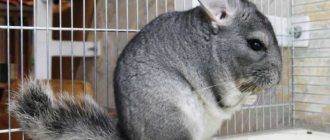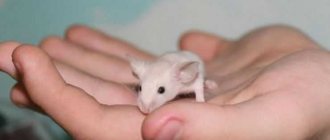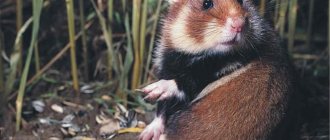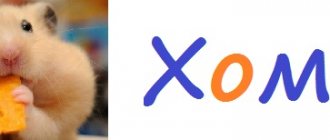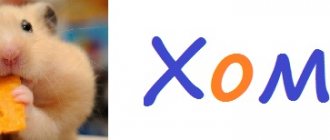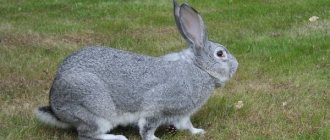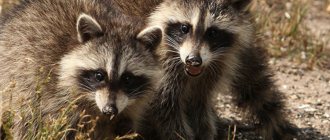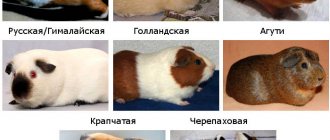Chinchillas are small animals from the order of rodents native to South America. Their habitat is the highlands of the South American Andes. Currently, there are very few chinchillas left in the wild; these animals were hunted for their fur, as a result of which the species is on the verge of extinction. Since the middle of the last century, chinchillas have been bred by amateurs as pets.
The chinchilla was first described by the English zoologist Edward Bennett in 1829.
Chinchilla - description and external characteristics
In appearance, the chinchilla resembles a large squirrel (they weigh from 300 to 800 g, and males are smaller than females), but in terms of its method of movement it is more like a rabbit. They have very thick, thin and soft fur, large dark eyes and large ears. The ears are the only organ of chinchillas that helps reduce body temperature - they are covered with a dense network of capillaries.
The body length of chinchillas is from 22 to 38 cm, the tail is 10-17 cm. The hind legs are longer than the front legs, thanks to which their movement resembles the jumping of a rabbit. Number of toes: four on the hind limbs, five on the front limbs. The front legs can make grasping movements.
The number of teeth reaches 20, and they grow throughout life. Therefore, it is very important for chinchillas to be able to chew something.
Baby chinchillas have white teeth, but adult chinchillas have orange teeth.
Varieties
The color of chinchillas is difficult to describe in one word. It is not enough to simply say “black”, “white” or “gray”. This is due to the fact that breeders have achieved that furry fur coats, in addition to the main colors, have many unusual shades. For a complete understanding, you need to consider each color separately.
Standard
Standard color breeds are closest in appearance to wild chinchillas. But among them there are many interesting varieties. For example:
- Grey . All hairs are unevenly colored - at the base they are light, gray-blue. And at the tips they are dark gray, closer to black. The back of gray chinchillas has a dark pattern, the sides are slightly lighter. And the color of the tummy is almost white.
- Light grey . These chinchillas have almost white paws and bellies. And the head, back and sides have a light gray, almost pearl color. Thanks to the smooth gradient, such animals look very airy.
- Moderately dark . The main part of the fur is dark gray in color. The tips of the hairs are black. On the face, the fur coat gradually acquires an ashen tint. The abdomen is slightly lighter than the rest of the body.
- Dark . The main distinguishing feature is the strong contrast of the almost white belly with the dark sides and back. There is a pleasant blue tint on the back, head and tail.
- Extra dark . The name speaks for itself. The fur of such fluffies is dark gray, almost black. The belly is almost white.
It is worth noting that when crossing the listed breeds, the color of the puppies is unpredictable. Even extra-dark parents can have light gray babies.
Beige
Chinchillas with beige fur have one similarity - with age, their fur can darken by 1-2 tones. But this should in no way be considered a disadvantage. On the contrary, this feature gives fluffies a special charm. The main varieties of beige chinchillas:
- Homobeige . They are distinguished by uniform light beige fur. At the same time, there are no spots on the fur coat, and there are no inclusions of dark hairs. The ears of such chinchillas are pink or cream in color.
- Heterobeige . Unlike representatives of the previous breed, these chinchillas have an uneven color. Typically, the bulk of their fur is light beige. And the bases and tips of the hairs are dark brown.
- Wellman beige . It is distinguished by a uniform beige color, lighter in the area of the ears, and also by expressive black eyes.
- Beige tower . The main color of the fur can be either light or dark beige. At the same time, there is always an interesting mosaic pattern on the back of the animal.
- Brown velvet . In fact, representatives of this breed have a three-color coloration. The leading color is rich beige. The back and head are colored brown, and the belly and legs are light sand.
- Beige Sullivan . These chinchillas are distinguished by a beige coat and red eyes, thanks to which they have a very mysterious appearance.
Most beige colors are due to recessive genes. Therefore, when such chinchillas are crossed with representatives of other breeds, darker puppies are born.
White fur
White chinchillas look very noble. Many are afraid to buy such light-colored pets due to concerns about the rapid contamination of the fur coat. However, these are just prejudices. Daily bathing completely eliminates the problem. The main varieties of white breeds:
- Albino . When describing this breed, a parallel can be drawn with rats. These chinchillas have completely white fur and red eyes. This effect is explained by the complete absence of coloring pigment in the animal’s genotype.
- White Wilson . It is distinguished by white fur with small admixtures of beige hairs. The ears are usually dark - smoky or charcoal gray. You can only buy such a pet from a professional breeder.
- White lova . These animals have a white tint with a slight cream tint. Another distinctive feature is ruby eyes.
- White velvet . The main feature of this breed is its white fur, which is velvety to the touch. Moreover, the ebb of fur directly depends on the sex of the animal. In males, the fur coat has a pleasant silvery tint. And the females have a warm beige color. At the same time, pronounced spots often appear on the face of the fluffies.
- White and pink . These chinchillas are distinguished by white coats with a wide pinkish stripe running along the back. Representatives of this breed also have pink ears. Another distinctive feature is large black eyes.
The main advantage of all white chinchillas is their unusual appearance. The light shade of their fur gives them a very elegant look.
Ebony
A special feature of ebony chinchillas is the interesting iridescence of their fur. Depending on the light source and its brightness, the fur coat of the same individual can look completely different. Some of the most interesting ebony colors:
- White ebony . Chinchillas are white or light beige in color, with black-tipped hairs. At first glance, it may seem that their fur coat has a border. There is a pronounced mask on their face. And the ears are completely covered with black hair.
- Homoeboni, or charcoal . The breed received this name due to its rich black coat color complete with black eyes. These chinchillas look very original.
- Heteroebony . They are similar to the previous breed, only their coat combines both black and gray hairs. Thanks to this, the fur acquires a smoky shade.
It is worth noting that due to the unusual sheen on the fur, ebony chinchillas have a bright, memorable appearance. Therefore, they often become winners of exhibitions and various competitions.
Dark color
Representatives of this group are black velvet chinchillas, bred in the 60s of the last century. These cute little fluffies have jet black fur, black eyes and a contrasting white belly. Sometimes the animal’s paws may also be white. It is worth noting that over time, the fur of these fluffies only becomes darker, which makes them even more attractive.
The gene that gives chinchilla fur its black color is lethal. Therefore, under no circumstances should a female and a male of this breed be crossed with each other. This greatly increases the risk of stillbirth.
Where do chinchillas live in the wild?
Chinchillas are found in the wild in the dry mountainous regions of Bolivia, Argentina and Chile. In these zones, the temperature in summer does not exceed +24 C, and in winter it drops to -20 C. The climate is dry, windy and cold. It is thanks to these living conditions that chinchillas have very valuable and thick fur.
The vegetation in the area where wild chinchillas live is quite sparse. Mostly cacti, shrubs, some cereal plants and herbs grow there. Such living conditions affected the diet of these animals. Their incredibly long intestines allow them to extract nutrients from fairly meager food. In an adult animal, the length of the small and large intestines reaches 3.5 m. Wild chinchillas feed only on plant foods: branches and bark of shrubs, succulents, dry herbs and leaves.
Chinchillas live in groups and are nocturnal. Up to hundreds of animals can live in one group. During the day they hide in natural shelters, such as crevices in rocks or in burrows dug by other animals. To protect against predators, the colony always has “observers” who warn the whole family about the danger with loud sounds.
Chinchillas are nocturnal animals, their large eyes and long sensitive whiskers (vibrissae) allow them to move unerringly in the dark.
In natural conditions, chinchillas form pairs. They produce one offspring per year. There are usually 2-4 cubs in a litter.
Unfortunately, at present the number of wild animals is very small, only about ten thousand. In 2008, the long-tailed chinchilla was declared a critically endangered species. And the short-tailed chinchilla, unfortunately, is an endangered species.
Reproduction
Chinchillas reach sexual maturity at the age of 6-9 months, with females maturing earlier than males. Despite the fact that rodents live in colonies, mating occurs with one permanent partner.
The first rut begins in the spring. The gestation period lasts a little more than 3 months. During this time, the female noticeably gains weight, and just before giving birth, she practically stops moving. 2-3 cubs are born in one litter. The animals are born sighted, they have teeth and are covered with fur. The female feeds the babies with milk for up to two months, but already on the 2-3rd day they begin to try plant foods.
Females give birth 2-3 times a year. Re-coating by the male occurs almost immediately after birth. Despite the ability of chinchillas to produce offspring several times per season, reproduction of the species does not occur as intensively as in other rodents due to the small number of litters.
Animals reproduce well in captivity. Thanks to many years of breeding work, it was possible to obtain many varieties with different fur colors. Today on chinchilla farms you can find individuals with a standard gray color, as well as beige, silver, white, black, brown, and purple. The rarer and more difficult the color mutation to obtain, the higher the price of the chinchilla.
What sounds do chinchillas make?
In nature, chinchillas live in groups and have developed a way of communicating with sounds. Their range ranges from a soft and quiet purr to a sharp whistle:
- mating rumbling calls of the male to mate;
- squeaking of babies - a demand for mother's attention or food;
- protest - sharp sounds that chinchillas make when quarreling or warning of danger;
- Chinchillas make very sharp and high-pitched sounds when angry, in a state of severe fright or when feeling pain.
How many years does a domestic chinchilla live?
Chinchillas are unusually active animals; they really like to jump, run and play. Life expectancy in captivity depends on how they are kept. How long can a chinchilla live at home? If you pay attention to their diet, keep the animals in a spacious cage, and give them the opportunity to communicate and move, then they can live quite a long time: eight to ten years or more.
Interesting Facts
- Chinchillas are perhaps the only animals whose life expectancy in captivity is shorter than in their natural habitat.
- To ensure that pets are properly cared for and fed, pet owners usually try to match the animal's life stages to the human life stages. There is no single formula that will determine the age of a chinchilla by human standards. It is generally accepted that the age of 1 month in rodents corresponds to 6 months in humans, 6 months - 14-16 years, 10-12 years - 40-45 years, and 20 years - 75 years.
- The beauty of chinchilla fur prompted breeders to develop new species of other animals with similar fur. This is how the breed of chinchilla rabbits and British chinchilla cats appeared.
- Chinchillas do not shed in the usual sense of the word. A complete change of coat occurs once in young individuals; subsequently, the coat is renewed daily by the loss of some of the old hairs.
Character
By nature, chinchillas are very affectionate and tame; they almost never bite. The animal can bite only in a state of severe fright. All chinchillas are different, some like to be petted and others not so much, and these character traits need to be respected. What chinchillas do not tolerate is violence. In order to achieve mutual understanding with the animal, you need to show patience and persistence, and respect the peculiarities of its character and behavior.
After purchasing a chinchilla, you need to leave it alone for about a week and let it get used to its new place. Then, unpersistently, you need to extend your hand to her with a treat. If the chinchilla wants, she will come up, take the treat and climb into your arms. If not, you need to continue taming it day after day until the animal gets used to you.
A chinchilla may become offended if you leave it alone for a long time or simply do not pay attention to it. She won't want to play with you and won't even take treats from your hands.
Chinchillas are very good at manipulating their owners. They know exactly what needs to be done to get what they want: they will sit in a corner and look at you with sad eyes, or they will jump on their hind legs to get a treat or go for a walk around the room.
Is it possible to train a chinchilla to go to the litter tray?
Chinchillas are very smart and learn quickly. It is very easy to train them to go to the litter box: place it in the cage in the place where the animal usually goes to the toilet, you need to remove all the bedding and wipe the floor of the cage with lemon. The chinchilla will immediately understand what needs to be done.
Tray
The second method: at first allow the animal to go to the toilet on the entire bedding at the bottom of the cage, but gradually reducing it every day. When a small patch remains, replace it with a small tray. The main thing is to change the bedding every day so that the cage is always dry.
Chinchilla color
The natural color of chinchillas is gray, but not uniform; they have a dark back and a white belly. The color can vary in saturation from light gray to almost black.
Amateurs have bred numerous color variations: white, black, beige, brown and others. There are also purple chinchillas, although their color is not exactly purple, but gray with a bluish or light purple tint. In total, there are about 240 different shades of domestic chinchilla color.
White-pink color
Tricolor color
Golden color
Completely black color
Purple color
Colors
Color is the main difference between chinchillas of different breeds. In this regard, the breeders have done a very good job. Therefore, now on the zoological market you can find fluffies of a wide variety of colors. All chinchillas, depending on color, are divided into several large groups:
- standard;
- beige;
- white fur;
- ebony;
- dark color.
Also among chinchillas there are individuals with fur of very rare interesting colors. For example, blue diamond, purple, sapphire, white and pink diamond.
In nature, only inconspicuous gray chinchillas are found. They may not look so attractive, but they are reliably protected from enemies. With the help of a gray fur coat, fluffies successfully blend into evening and night landscapes.
Diet
Chinchillas are quite delicate animals, and their diet at home must be selected very carefully. What do chinchillas eat? The main food for them is dry hay (it must be properly dried, with a pleasant herbal smell).
Fresh, high-quality hay should always be in the cage. If there is not enough hay, the animal may die.
In addition to hay, the chinchilla is fed with special food, and the following are suitable complementary foods: cereal flakes, dried leaves, herbs or roots, corn and flax seed, dried pieces of vegetables. These animals happily gnaw on branches of fruit trees and bushes: apple, cherry, raspberry or currant trees. The main thing is that everything is dry and free of moisture.
Chinchillas need to be given water. Make sure the water is always fresh.
A responsible attitude to the selection of chinchilla nutrition prolongs their life; more than half of the animals die prematurely from intestinal disorders.
Keeping at home
Keeping and caring for chinchillas at home is not difficult. But there are some important conditions that must be adhered to. Chinchillas need spacious, wide cages, preferably high ones, similar to enclosures; the animals are very active and must move a lot. For one animal, a cage of the following dimensions is suitable: 100 cm high, 80 cm long and 50 cm wide.
Chinchillas love to climb to heights, so it is advisable to give them this opportunity by installing wooden shelves in the cage. There is no need for ladders to connect floors, as chinchillas love to jump. In addition to shelves, it is advisable to install in the cage: a spacious wooden house, hammocks, tunnels and a running wheel.
Chew toys are also needed. These could be: small branches, wooden blocks, salt or chalk stone.
When choosing a cage, pay attention to the presence of plastic parts; they should not be in the cage, because... chinchillas chew and eat everything, and plastic can cause intestinal obstruction and death of the animal.
In addition, the chinchilla needs to be let out of the cage for a couple of hours a day, but at the same time monitored, since they like to chew everything that comes their way, including wires and furniture.
The bottom of the cage can be left clean, without filler, and in the corner of the cage you can install a tray where the chinchilla will go to the toilet.
Chinchillas are strictly prohibited from bathing in water! To clean their coats, they bathe in sand. Sand for this purpose should be used very fine and clean.
A container of sand can be placed in and next to the cage several times a week. There is no need to leave it on for a long time, as bathing chinchillas too often can cause dry skin.
If there is no filler at the bottom of the cage, then the cage should be swept daily with a small broom, removing excrement. It is advisable to wipe the shelves daily with natural detergents.
Other breeds
There are many more breeds of chinchillas - for every taste and color. The following varieties are most often found in Russian nurseries:
- Silver Mosaic is a hybrid of a white chinchilla and a standard breed. It is distinguished by white fur with numerous gray patches. From a distance, the fur of representatives of this breed appears pearly.
- White mosaic - similar to the previous breed, but the white and gray areas have clearer outlines.
- Violet is a very rare variety. Breeding is complicated by late puberty. Animals are ready to mate only from the age of one and a half years. They have a light lilac back and a white belly. The face and ears are a more saturated purple hue.
- White and pink diamond . It is distinguished by light fur with a pink tint. Ears, nose and paws are pale pink. It is worth noting that the genotype of representatives of this breed also contains a lethal gene. Therefore, they are only allowed to be crossed with chinchillas of other varieties.
- Sapphire is one of the most beautiful and expensive rocks. The fur coat has a gray-blue tint, the tummy is pale blue. The ears are pale pink. The look is complemented by large beady eyes. It is better to buy representatives of this breed after reaching 7-8 months, since it is at this age that the formation of coat color ends.
- Blue diamond - distinguished by a fur coat of a rich gray-blue hue with a metallic tint. There is a dark ornate pattern running along the spine.
It is worth noting that there are so many chinchilla breeds that in search of the rarest and most beautiful, novice breeders simply begin to get confused. For example, some are trying to find the elusive Siberian chinchilla. And absolutely in vain. Because in fact, this is one of the long-haired cat breeds.
Chinchilla health
A healthy adult animal should weigh at least 500 g. You also need to pay attention to the color of the teeth. If teeth begin to turn white, losing their orange color, this is the first sign of calcium deficiency. The fur should be smooth and shiny.
People often ask whether a chinchilla needs special care. No special care is needed, but it is better to contact a veterinarian if you notice that your animal:
- refuses food;
- lethargic and passive;
- falls over on its side.
In the room where the animal lives, the air temperature should be no higher than 26 degrees. High air temperatures can cause heatstroke in a chinchilla.

